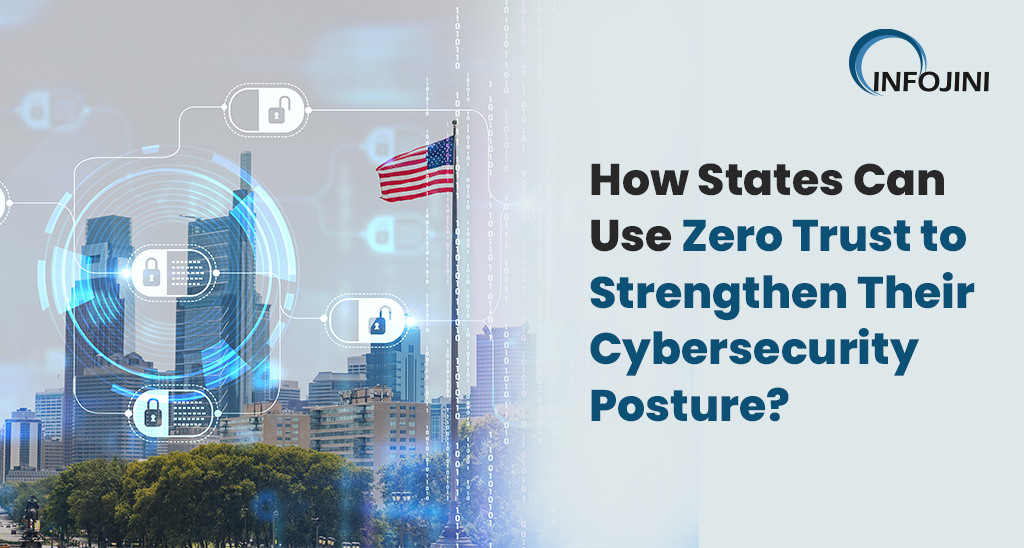How States Can Use Zero Trust to Strengthen Their Cybersecurity Posture?
In today’s world, cybersecurity has become a critical aspect for governments and organizations of all sizes. Hackers are coming up with new and sophisticated ways to breach cybersecurity defenses almost every day. This makes it imperative for governments to implement security measures that can protect their sensitive data and infrastructure. One such approach is the Zero Trust security model, which is increasingly being adopted by various states to improve their cybersecurity posture. In this blog, we will discuss how states can use Zero Trust to improve their cybersecurity posture.
Understanding the Zero Trust Model
The Zero Trust model is a security approach that assumes that all devices and users on a network, even those within an organization’s perimeter, are potential threats. The model focuses on the principle of least privilege, which means that users and devices are only given access to the resources they need to do their jobs. This approach ensures that even if one part of the system is compromised, attackers will not have access to sensitive data or infrastructure. The Zero Trust model is a significant shift from the traditional perimeter-based security model, which assumes that everything within an organization’s network can be trusted.
Implementing Zero Trust in State Governments
Implementing Zero Trust in state governments involves several steps, including the following:
- Identify and classify data: The first step in implementing Zero Trust is to identify and classify the data that needs to be protected. This data could include sensitive information such as social security numbers, financial data, and health records. Once this data is identified, it should be classified according to its level of sensitivity.
- Access control: The second step is to implement access control policies that restrict access to sensitive data and resources. This involves creating policies that determine who has access to what data and resources and ensuring that these policies are enforced across the network.
- Multifactor authentication: Multifactor authentication is a critical component of the Zero Trust model. This involves requiring users to provide more than one form of identification, such as a password and a fingerprint or a smart card before they can access sensitive data or resources.
- Monitoring and logging: Monitoring and logging are essential components of the Zero Trust model. This involves monitoring all network traffic and logging all activity to detect any unusual behavior that could indicate a potential security breach.
Benefits of Zero Trust
Implementing Zero Trust in state governments has several benefits, including the following:
- Improved security: Zero Trust is a more secure model than the traditional perimeter-based security model. This is because it assumes that all devices and users are potential threats, which means that security policies are enforced across the network.
- Better visibility: Zero Trust provides better visibility into network traffic, which means that state governments can detect and respond to potential security breaches more quickly.
- Compliance: Implementing Zero Trust can help state governments comply with various regulations, such as the Health Insurance Portability and Accountability Act (HIPAA) and the General Data Protection Regulation (GDPR).
- Cost-effective: Implementing Zero Trust can be more cost-effective than traditional security models. This is because it focuses on the principle of least privilege, which means that users and devices are only given access to the resources they need to do their jobs.
Challenges of Zero Trust
While implementing Zero Trust in state governments has several benefits, it also comes with several challenges, including the following:
- Complexity: Implementing Zero Trust can be complex, especially in large organizations. This is because it requires a significant shift in the way security is approached.
- User experience: Implementing Zero Trust can affect user experience, especially if access control policies are too strict. This can result in employees having to go through multiple authentication steps to access resources, which can be frustrating.
- Integration: Implementing Zero Trust requires integration with existing systems and applications, which can be challenging.
Advantages of Partnering with Infojini
Infojini is a staffing and recruiting company that primarily focuses on providing staff augmentation services to its clients in various industries. By partnering with Infojini Staffing, states can access a pool of highly skilled cybersecurity professionals who can help them implement the Zero Trust model and other security measures. Infojini Staffing can assist states in the following ways:
- Identifying and recruiting cybersecurity talent: Infojini Staffing can help states identify and recruit highly skilled cybersecurity professionals who can help them implement the Zero Trust model and other security measures.
- Providing staffing and consulting services: Infojini Staffing can provide staffing and consulting services to help states with their cybersecurity staffing needs.
- Offering training and support: Infojini Staffing can provide training and support to ensure that the cybersecurity professionals they provide are well-equipped to implement the Zero Trust model and other security measures effectively.
Conclusion
The Zero Trust model is a security approach that state governments can adopt to improve their cybersecurity posture. The model focuses on the principle of least privilege, which ensures that users and devices are only given access to the resources they need to do their jobs. By implementing Zero Trust, state governments can improve their security, compliance, and cost-effectiveness. However, implementing Zero Trust can also come with several challenges, such as complexity, user experience, and integration. Overall, the benefits of Zero Trust outweigh the challenges, and state governments should consider implementing this model to protect their sensitive data and infrastructure. With cybersecurity threats rising, it is essential for state governments to adopt innovative and effective security measures such as Zero Trust.
Infojini Staffing can assist states by providing them with qualified and experienced cybersecurity professionals who can help them implement the Zero Trust model and other security measures to stay ahead of the curve and safeguard against cyber-attacks.
Case Study – Government Agency
A large government agency of the state government, works on
information technology solutions
Subscribe For Updates
Categories
- Accountant
- AI
- Automation
- Awards and Recognitions
- Blue Collar Staffing
- Burnouts
- Campus Recruiting
- Cloud
- Co-Ops agreements
- Company Culture
- Compliance
- contingent workforce
- Contingent Workforce
- COVID-19
- Cyber Security Staffing
- Data Strategy
- Digital Transformation
- direct sourcing
- Distributed Workforce
- Diversity
- Diversity & Inclusion
- Economy
- Events & Conferences
- fleet industry
- Gig Economy
- Girls in Tech
- Global Talent Research and Staffing
- Government
- Healthcare
- Healthcare Staffing
- Hiring Process
- Hiring Trends
- Home Helathcare
- HR
- HR Practices
- HR Tech
- IT
- Labor Shortages
- Life Science
- Local Governments
- News
- Nursing
- Payroll Staffing
- Public Sectors
- Recruiting
- Remote Work
- Skill Gap
- SMB Hiring
- Snowflake
- Staffing
- Staffing Augmentation
- Staffing Challenges
- Talent ROI
- Tech Staffing
- Technology
- Tips & tricks
- Total Talent Management
- UI/UX Design
- Uncategorized
- Veteran Staffing
- Veterans Hiring
- Veterans Hiring
- Workforce Management
Recent Posts
- Automation in Recruiting: From Chatbots to Predictive Screening
- Gig Economy Expansion: The Impact on Talent Pools and Business Models
- Skills-Based Hiring: Why Credentials Alone Don’t Cut It in 2025
- Procurement 3.0: AI & Intelligent Automation in 2025
- Q3 Is Here: Is Your Contingent Workforce Strategy Falling Behind?
Newsletter
Archive
- September 2025
- August 2025
- June 2025
- April 2025
- March 2025
- December 2024
- November 2024
- October 2024
- September 2024
- August 2024
- July 2024
- June 2024
- May 2024
- April 2024
- March 2024
- February 2024
- January 2024
- December 2023
- November 2023
- October 2023
- September 2023
- August 2023
- July 2023
- June 2023
- May 2023
- April 2023
- March 2023
- February 2023
- December 2022
- November 2022
- October 2022
- September 2022
- August 2022
- July 2022
- June 2022
- November 2021
- October 2021
- September 2021
- August 2021
- July 2021
- June 2021
- May 2021
- April 2021
- March 2021
- February 2021
- January 2021
- December 2020
- November 2020
- October 2020
- September 2020
- August 2020
- July 2020
- June 2020
- May 2020
- April 2020
- March 2020
- February 2020
- January 2020
- December 2019
- November 2019
- October 2019
- September 2019
- August 2019
- July 2019
- June 2019
- May 2019
- January 2019
- December 2018
- November 2018
- October 2018
- September 2018
- August 2018
- July 2018
- June 2018
- May 2018
- April 2018
- March 2018
- February 2018
- January 2018
- December 2017
- November 2017
- October 2017
- September 2017
- August 2017
- July 2017
- June 2017
- May 2017
- November 2016
- October 2016




